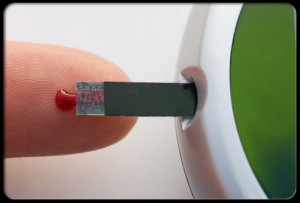Your body must carefully regulate your blood sugar levels with a limited range. Upon waking, blood sugar should be between 70 and 100 mg/dl (milligrams per deciliter). When you eat your blood sugar will rise but should not get above 135 to 140 mg/dl. Blood sugar levels that are either habitually too high, or too low, are extremely damaging to health and can even be fatal.
When your body is not effectively keeping your blood sugar levels within tolerable limits it is known as “blood sugar dysregulation”. Unfortunately, many are unaware that blood sugar dysregulation can span a continuum starting with hypoglycemia, progressing to insulin resistance, and finally progressing to type 2 diabetes. It’s important to understand this and to intervene in the early stages of this progression.
If caught in its early stages, blood sugar dysregulation can be reversed through dietary and lifestyle changes.
BLOOD SUGAR TEST FOR DIABETES
The American Diabetes Association’s current criteria for a diabetes diagnosis are as follows:
Symptoms of diabetes plus a casual plasma glucose of 200 mg/dL or greater.
OR
Fasting plasma glucose of 126 mg/dL or greater.
OR
Plasma glucose of 200 mg/dL or greater at 2 hours following a 75-gram glucose load.
At least one of the above criteria must be met on more than one occasion. A typical blood glucose test involves drawing blood after a 12 hour fast, then drinking 75 grams of glucose, waiting 2 hours and drawing blood once again. Lab paperwork may refer to the blood test after the glucose drink as postprandial.
The blood will be evaluated for both insulin and glucose. The fasting blood work should demonstrate glucose and insulin levels within the reference ranges listed on the lab paperwork. After a dose of glucose the blood glucose level and the level of secreted insulin should both increase. A normal response is a return to < 110 mg/dl after 2 hours.
Other factors can mimic high blood sugar and must be ruled out before a diagnosis can be given. These other factors are primarily related to a fairly wide variety of prescription drugs.
BLOOD SUGAR TEST FOR INSULIN RESISTANCE
Insulin resistance is defined by an insulin level greater than 23 one-hour after the glucose drink is ingested. Values below 23 are considered normal. Different labs will often use different reference ranges.
GLOSSARY OF TERMS
Casual Plasma Glucose Test is another test for determining diabetes. The “Casual” test does not involve fasting. The blood sugar level is tested without regard to when the person last ate. If the glucose level is above 200 mg/dl it may indicate diabetes, especially if repeated tests yield the same result.
The glucose drink may be any one of a number of name brands. It typically comes in a 12 oz bottle and contains 75 g of glucose. The 75 grams is the World Health Organization (WHO) recommended adult dose for glucose tolerance tests. It is usually flavored and carbonated. Typical ingredients include a dextrin (sugar) syrup, water, acidity control chemical, preservatives, food coloring, and carbonic acid.
Hyperglycemia is an abnormally HIGH concentration of glucose in the blood. The condition is often associated with diabetes.
Hypoglycemia is an abnormally LOW concentration of glucose in the blood. The condition is often a precursor to insulin resistance.
Insulin Resistance is the name given to a group of symptoms which indicate an elevated risk for coronary disease, stroke, and diabetes. It is also known by the terms metabolic syndrome and syndrome x. The two most critical factors are 1) excess weight around the middle and upper body, sometimes referred to as “pear-shaped” and 2) the inability of the body to use insulin effectively (insulin resistance) thus requiring higher and higher levels of insulin to manage blood sugar levels.
Postprandial means after eating a meal. Preprandial means before eating a meal. The typical diabetes test involves retesting glucose levels 2 hours after (postprandial) consuming a glucose drink.
Symptoms of diabetes, according to the American Diabetes Association, are as follows;
Type 1 Diabetes
· Frequent urination
· Unusual thirst
· Extreme hunger
· Unusual weight loss
· Extreme fatigue and Irritability
Type 2 Diabetes
· Any of the type 1 symptoms
· Frequent infections
· Blurred vision
· Cuts/bruises that are slow to heal
· Tingling/numbness in the hands/feet
· Recurring skin, gum, or bladder infections
Written by Peter Wright
Photo 1 Picasa Web Album, Feb 2, 2012, Saúde e Harmonia photos, Album: EDUCAÇÃO À DISTANCIA,
Latest posts by Peter Wright, NTP, CGP (see all)
- Dehydrated Broth – Making It Easy to Drink Broth Every Day! - March 11, 2017
- Lose 10 lbs DURING the Holidays - November 19, 2016
- Finding Good Oils - February 7, 2016



No comments yet.